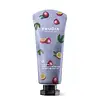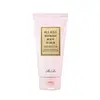What's inside
What's inside
 Key Ingredients
Key Ingredients

No key ingredients
 Benefits
Benefits

 Concerns
Concerns

 Ingredients Side-by-side
Ingredients Side-by-side

Water
Skin ConditioningGlycerin
HumectantCetyl Alcohol
EmollientParaffinum Liquidum
EmollientDipropylene Glycol
HumectantDimethicone
EmollientCyclopentasiloxane
EmollientStearyl Alcohol
EmollientGlyceryl Stearate
EmollientPEG-100 Stearate
Polysorbate 60
EmulsifyingMyristyl Alcohol
EmollientSorbitan Stearate
EmulsifyingAcrylates/C10-30 Alkyl Acrylate Crosspolymer
Emulsion StabilisingSqualane
EmollientErythritol
HumectantButyrospermum Parkii Butter
Skin ConditioningPunica Granatum Fruit Extract
AntioxidantLauryl Alcohol
EmollientCoco-Caprylate/Caprate
EmollientButylene Glycol
HumectantXanthan Gum
EmulsifyingPotassium Hydroxide
BufferingAdenosine
Skin ConditioningVitis Vinifera Seed Oil
EmollientPrunus Armeniaca Kernel Oil
MaskingPassiflora Edulis Fruit Extract
Skin ConditioningPanthenol
Skin ConditioningSolanum Lycopersicum Seed Oil
EmollientPunica Granatum Seed Oil
EmollientMangifera Indica Seed Oil
EmollientCitrus Paradisi Seed Oil
PerfumingHoney Extract
HumectantCentella Asiatica Extract
CleansingTocopherol
AntioxidantDisodium EDTA
Chlorphenesin
AntimicrobialPhenoxyethanol
Preservative1,2-Hexanediol
Skin ConditioningParfum
MaskingLinalool
PerfumingBenzyl Benzoate
AntimicrobialHexyl Cinnamal
PerfumingLimonene
PerfumingWater, Glycerin, Cetyl Alcohol, Paraffinum Liquidum, Dipropylene Glycol, Dimethicone, Cyclopentasiloxane, Stearyl Alcohol, Glyceryl Stearate, PEG-100 Stearate, Polysorbate 60, Myristyl Alcohol, Sorbitan Stearate, Acrylates/C10-30 Alkyl Acrylate Crosspolymer, Squalane, Erythritol, Butyrospermum Parkii Butter, Punica Granatum Fruit Extract, Lauryl Alcohol, Coco-Caprylate/Caprate, Butylene Glycol, Xanthan Gum, Potassium Hydroxide, Adenosine, Vitis Vinifera Seed Oil, Prunus Armeniaca Kernel Oil, Passiflora Edulis Fruit Extract, Panthenol, Solanum Lycopersicum Seed Oil, Punica Granatum Seed Oil, Mangifera Indica Seed Oil, Citrus Paradisi Seed Oil, Honey Extract, Centella Asiatica Extract, Tocopherol, Disodium EDTA, Chlorphenesin, Phenoxyethanol, 1,2-Hexanediol, Parfum, Linalool, Benzyl Benzoate, Hexyl Cinnamal, Limonene
Water
Skin ConditioningJuglans Regia Shell Extract
Skin ConditioningAmmonium Lauryl Sulfate
CleansingGlycerin
HumectantAcrylates Copolymer
Triethanolamine
BufferingSodium Laureth Sulfate
CleansingCocamidopropyl Betaine
CleansingCocamide DEA
EmulsifyingDimethicone
EmollientParfum
MaskingSodium Chloride
MaskingPotassium Cocoyl Glycinate
Polyquaternium-7
Phenoxyethanol
PreservativePentylene Glycol
Skin ConditioningPropanediol
SolventHelianthus Annuus Seed Oil
EmollientVitis Vinifera Seed Oil
EmollientPinus Sylvestris Leaf Extract
TonicCocos Nucifera Fruit Extract
EmollientDisodium EDTA
Chamomilla Recutita Flower/Leaf Extract
AntimicrobialSalvia Sclarea Extract
AntiseborrhoeicLavandula Angustifolia Water
MaskingHyacinthus Orientalis Extract
Skin ConditioningBorago Officinalis Extract
EmollientCentaurea Cyanus Flower Extract
AstringentButylene Glycol
Humectant1,2-Hexanediol
Skin ConditioningEthylhexylglycerin
Skin ConditioningWater, Juglans Regia Shell Extract, Ammonium Lauryl Sulfate, Glycerin, Acrylates Copolymer, Triethanolamine, Sodium Laureth Sulfate, Cocamidopropyl Betaine, Cocamide DEA, Dimethicone, Parfum, Sodium Chloride, Potassium Cocoyl Glycinate, Polyquaternium-7, Phenoxyethanol, Pentylene Glycol, Propanediol, Helianthus Annuus Seed Oil, Vitis Vinifera Seed Oil, Pinus Sylvestris Leaf Extract, Cocos Nucifera Fruit Extract, Disodium EDTA, Chamomilla Recutita Flower/Leaf Extract, Salvia Sclarea Extract, Lavandula Angustifolia Water, Hyacinthus Orientalis Extract, Borago Officinalis Extract, Centaurea Cyanus Flower Extract, Butylene Glycol, 1,2-Hexanediol, Ethylhexylglycerin
Ingredients Explained
These ingredients are found in both products.
Ingredients higher up in an ingredient list are typically present in a larger amount.
1,2-Hexanediol is a synthetic liquid and another multi-functional powerhouse.
It is a:
- Humectant, drawing moisture into the skin
- Emollient, helping to soften skin
- Solvent, dispersing and stabilizing formulas
- Preservative booster, enhancing the antimicrobial activity of other preservatives
Butylene Glycol (or BG) is used within cosmetic products for a few different reasons:
Overall, Butylene Glycol is a safe and well-rounded ingredient that works well with other ingredients.
Though this ingredient works well with most skin types, some people with sensitive skin may experience a reaction such as allergic rashes, closed comedones, or itchiness.
Learn more about Butylene GlycolDimethicone is a type of synthetic silicone created from natural materials such as quartz.
What it does:
Dimethicone comes in different viscosities:
Depending on the viscosity, dimethicone has different properties.
Ingredients lists don't always show which type is used, so we recommend reaching out to the brand if you have questions about the viscosity.
This ingredient is unlikely to cause irritation because it does not get absorbed into skin. However, people with silicone allergies should be careful about using this ingredient.
Note: Dimethicone may contribute to pilling. This is because it is not oil or water soluble, so pilling may occur when layered with products. When mixed with heavy oils in a formula, the outcome is also quite greasy.
Learn more about DimethiconeDisodium EDTA plays a role in making products more stable by aiding other preservatives.
It is a chelating agent, meaning it neutralizes metal ions that may be found in a product.
Disodium EDTA is a salt of edetic acid and is found to be safe in cosmetic ingredients.
Learn more about Disodium EDTAGlycerin is already naturally found in your skin. It helps moisturize and protect your skin.
A study from 2016 found glycerin to be more effective as a humectant than AHAs and hyaluronic acid.
As a humectant, it helps the skin stay hydrated by pulling moisture to your skin. The low molecular weight of glycerin allows it to pull moisture into the deeper layers of your skin.
Hydrated skin improves your skin barrier; Your skin barrier helps protect against irritants and bacteria.
Glycerin has also been found to have antimicrobial and antiviral properties. Due to these properties, glycerin is often used in wound and burn treatments.
In cosmetics, glycerin is usually derived from plants such as soybean or palm. However, it can also be sourced from animals, such as tallow or animal fat.
This ingredient is organic, colorless, odorless, and non-toxic.
Glycerin is the name for this ingredient in American English. British English uses Glycerol/Glycerine.
Learn more about GlycerinParfum is a catch-all term for an ingredient or more that is used to give a scent to products.
Also called "fragrance", this ingredient can be a blend of hundreds of chemicals or plant oils. This means every product with "fragrance" or "parfum" in the ingredients list is a different mixture.
For instance, Habanolide is a proprietary trade name for a specific aroma chemical. When used as a fragrance ingredient in cosmetics, most aroma chemicals fall under the broad labeling category of “FRAGRANCE” or “PARFUM” according to EU and US regulations.
The term 'parfum' or 'fragrance' is not regulated in many countries. In many cases, it is up to the brand to define this term.
For instance, many brands choose to label themselves as "fragrance-free" because they are not using synthetic fragrances. However, their products may still contain ingredients such as essential oils that are considered a fragrance by INCI standards.
One example is Calendula flower extract. Calendula is an essential oil that still imparts a scent or 'fragrance'.
Depending on the blend, the ingredients in the mixture can cause allergies and sensitivities on the skin. Some ingredients that are known EU allergens include linalool and citronellol.
Parfum can also be used to mask or cover an unpleasant scent.
The bottom line is: not all fragrances/parfum/ingredients are created equally. If you are worried about fragrances, we recommend taking a closer look at an ingredient. And of course, we always recommend speaking with a professional.
Learn more about ParfumPhenoxyethanol is a preservative that has germicide, antimicrobial, and aromatic properties. Studies show that phenoxyethanol can prevent microbial growth. By itself, it has a scent that is similar to that of a rose.
It's often used in formulations along with Caprylyl Glycol to preserve the shelf life of products.
Vitis Vinifera Seed Oil comes from the grape vine. Grape seeds are a byproduct of creating grape juice or wine.
The components of grape seeds have many skin benefits. Research has found it to be antimicrobial and anti-inflammatory. It also contains many potent antioxidants such as Vitamin E , Vitamin C, proanthocyanidins, polyphenols, flavonoids, and anthocyanins. Proanthocyanidin has been shown to help even out skin tone.
Antioxidants help fight free-radical molecules. Free-radical molecules are capable of damaging our cells and other genetic material. Antioxidants help stabilize free-radicals by donating extra electrons. Grape seed extract may help reduce the signs of aging.
The antimicrobial properties of grape seed may help treat acne. However, more research is needed to support this claim.
Grape seed has also been found to help absorb UV rays. Grape seed extract should not replace your sunscreen.
The fatty acids of grape seed oil give it emollient properties. Emollients help soothe and soften your skin by creating a film. This film traps moisture within, keeping your skin hydrated.
Learn more about Vitis Vinifera Seed OilWater. It's the most common cosmetic ingredient of all. You'll usually see it at the top of ingredient lists, meaning that it makes up the largest part of the product.
So why is it so popular? Water most often acts as a solvent - this means that it helps dissolve other ingredients into the formulation.
You'll also recognize water as that liquid we all need to stay alive. If you see this, drink a glass of water. Stay hydrated!
Learn more about Water